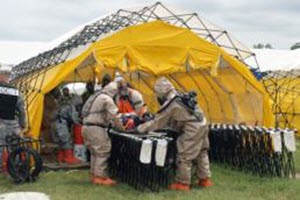Story by: Sgt. Suzanne Carter
Posted: April 24, 2015
 Courtesy Photo
Courtesy Photo
Guardsmen with the Texas National Guard's 836th Chemical Company, 6th Chemical, Biological, Radiological, Nuclear, and High-Yield Explosives (CBRNE) Enhanced Response Force Package, Joint Task Force 136 (Maneuver Enhancement Brigade), move an injured civilian into a chemical decontamination line during a training exercise at Govalle Waste Water Treatment Plant in Austin, Texas, as part of their weeklong annual training period April 22, 2015. (U.S. Army National Guard photo by Spc. Martha Guerrero/Released)
BASTROP, Texas - National Guard troops of the Joint Task Force 136 (Maneuver Enhancement Brigade) conducted dual mission training exercises at Camp Swift in Bastrop, Texas and other locations around the state during their weeklong annual training period April 19-26, 2015.
Service members practiced their Soldier skills while performing emergency response operations in order to build competence as the custodians of the FEMA Region VI Homeland Response Force mission.
“Any time that we’re training, we’re going to be doing both our Defense Support to Civil Authorities mission as well as our Army mission,” said Col. Lee Schnell, JTF 136 (MEB) commander. “It’s kind of just what we do.”
Training for the brigade’s DSCA mission provided opportunities for Soldiers to apply their warrior tasks and military occupational specialty skills. Members of the 436th Chemical Company, part of the 6th Chemical, Biological, Radiological, Nuclear, and high-yield Explosive (CBRNE) Enhanced Response Force Package, said that their experience with Army equipment supports their HRF mission readiness.
“We are conducting reconnaissance operations in buddy teams using a joint chemical agent detector,” Sgt. Cody Hammond said. “We use these to find a contaminated area so that we can mark the terrain and give the command element a picture of the area of operations. If necessary, we can use these during a [DSCA] mission.”
Soldiers and their leaders valued the chance to work with their military (green) equipment, getting back to the basics of their traditional Army role while still supporting their disaster response (white) mission.
“This year we are going to continue with more green training in combination with the white because we need to be ready for both missions,” said Capt. Marilu Wilkinson, commander of the 436th Chemical Company. “[The Soldiers are] getting some good training with the equipment. They’re very excited to do this green training.”
Maintaining their HRF mission means that the brigade must be prepared to react to natural disasters, terrorist attacks, or other devastating incidents that may occur in Texas, Arkansas, Oklahoma, Louisiana, or New Mexico. Covering such a diverse region means that Soldiers must be mobile and adaptable to any environment, which is why the troops trained at the Govalle Waste Water Treatment Plant in Austin and Disaster City in College Station, in addition to Camp Swift. Training for the HRF mission includes responding to notional scenarios with the full force of the brigade’s capabilities like chemical decontamination, search and rescue and medical triage.
“We responded to a plane crash that involved a large number of personnel in a contaminated environment,” said Sgt. 1st Class Jason Sanchez, a platoon sergeant with 836th Engineer Company, also part of the 6th CERFP, about the Govalle scenario of their annual training. “During that exercise we allowed our junior members to go ahead and take charge while our senior leaders became the worker bees. The results were astounding.”
Sanchez said that giving junior Soldiers control of the situation allowed them to take ownership of their role in the response efforts and perform above expectations.
“They reacted well to the situation, called up reports, kept everybody informed, provided a good plan for their response, and then sent up a clear picture of the situation to the leadership in the [tactical operations center],” he said.
Spc. Kimberly Pena with the 236th Military Police Company, part of the CBRNE Assistance Support Element, appreciated the opportunity to be more responsible for her role in supporting emergency response efforts, which includes guiding civilians toward help.
“We have to be in communication with other elements on the ground to find out the information that we need,” she said. “It’s not up to the [noncommissioned officers] to always do that for us. It’s more individual responsibility to talk to civilians and get them where they need to go to get help.”
Pushing junior service members into leadership roles expands their capacity for overcoming obstacles and accomplishing any mission that comes their way.
“What Soldiers do best is solving problems creatively,” Schnell said. “This training puts leadership in the environment where they have to use the Soldiers to the best of their abilities and challenge everybody all the way up and down the chain of command. Our junior members are very smart when it comes to solving problems and our leaders are learning that if they give their Soldiers broad directions, they can count on the Soldiers to figure out a solution.”
Conducting dual trainings like this not only encourages Soldiers to take on more active roles in their training, but also brings them together as a team and builds morale.
“The teamwork, the adventure, the excitement, the communication,” said Pfc. Espinoza Mariano of the 836th Engineer Company, “everything about it has been awesome.”